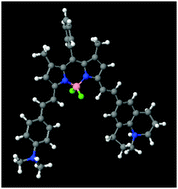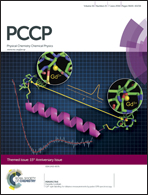A hybrid bis(amino-styryl) substituted Bodipy dye and its conjugate diacid: synthesis, structure, spectroscopy and quantum chemical calculations†
Abstract
A new type of fluorescent pH indicator has been developed whereby two dissimilar amino-styryl units are attached to a boron dipyrromethene (Bodipy) dye. The photophysical properties of this hybrid dye, and its simpler counterparts bearing only a single amino-styryl residue, depend on the polarity of the surrounding medium. Of the two terminal amines, DFT (B3LYP/6-31G**) calculations and spectroscopic measurements support the notion that julolidine is oxidised and protonated under milder conditions than is N,N-dimethylaniline. For the hybrid dye, similar DFT calculations carried out for the mono-protonated analogues indicate that the julolidine residue is the stronger base while the resultant conjugate acid is the weaker one. Absorption and fluorescence spectroscopic titrations show that protonation of the hybrid dye occurs in two well-resolved steps, whereby addition of the first proton introduces a thermodynamic barrier for entry of the second. In the hybrid dye, the pKA values for the respective conjugate acids differ markedly from those derived for the mono-amino-styryl dyes and display negative co-operativity. Effectively, this means that electronic interactions running along the molecular backbone make it more difficult, relative to the individual dyes, to protonate both amino sites. As such, this dye operates as a probe over an unusually wide pH range.

- This article is part of the themed collection: PCCP’s 15th anniversary

 Please wait while we load your content...
Please wait while we load your content...